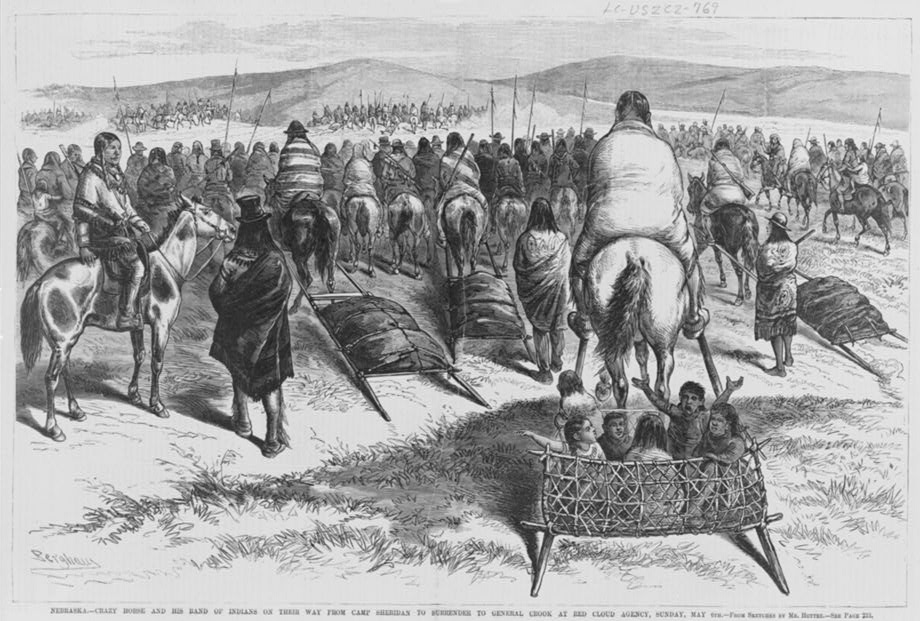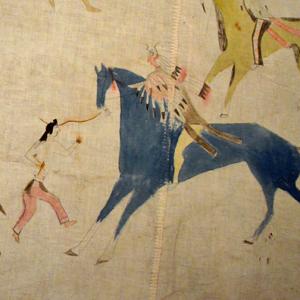|
Encouraging Bear
Encouraging Bear, also known as Horn Chips (Lakota: ''Ptehé Wóptuȟ’a''), was a noted Oglala Lakota medicine man, and the spiritual advisor to Crazy Horse, a Lakota war leader of the Oglala The Oglala (pronounced , meaning 'to scatter one's own' in Lakota) are one of the seven subtribes of the Lakota people who, along with the Dakota, make up the Očhéthi Šakówiŋ (Seven Council Fires). A majority of the Oglala live on the P ... band in the 19th century. Horn Chips was born in 1824 near Ft. Teton. He was orphaned as a young child and raised by his grandmother. Later he was adopted by the uncle of Crazy Horse. Chips and Crazy Horse were raised together. He is said to have had the gift of prophecy, being able to change the weather, and find lost objects and missing people. He is also acknowledged as the man who saved traditional Lakota religion from extinction and trained a number of successors. Chips was present when Crazy Horse was killed. When the soldier jerke ... [...More Info...] [...Related Items...] OR: [Wikipedia] [Google] [Baidu] |
Lakota Language
Lakota ( ), also referred to as Lakhota, Teton or Teton Sioux, is a Siouan languages, Siouan language spoken by the Lakota people of the Sioux tribes. Lakota is mutually intelligible with the two dialects of the Dakota language, especially Dakota language#Comparison of the dialects, Western Dakota, and is one of the three major variety (linguistics), varieties of the Sioux language. Speakers of the Lakota language make up one of the largest Native American language speech communities in the United States, with approximately 2,000 speakers, who live mostly in the northern plains states of North Dakota and South Dakota. Many communities have immersion programs for both children and adults. Like many indigenous languages, the Lakota language did not have a written form traditionally. However, efforts to develop a written form of Lakota began, primarily through the work of Christian missionaries and linguists, in the late 19th and early 20th centuries. The orthography has since evol ... [...More Info...] [...Related Items...] OR: [Wikipedia] [Google] [Baidu] |
Oglala Lakota
The Oglala (pronounced , meaning 'to scatter one's own' in Lakota language, Lakota) are one of the seven subtribes of the Lakota people who, along with the Dakota people, Dakota, make up the Sioux, Očhéthi Šakówiŋ (Seven Council Fires). A majority of the Oglala live on the Pine Ridge Indian Reservation in South Dakota, the eighth-largest Indian reservation, Native American reservation in the United States. The Oglala are a List of federally recognized tribes, federally recognized tribe whose official title is the called the Oglala Sioux Tribe of the Pine Ridge Reservation, South Dakota. History Oglala elders relate stories about the origin of the name "Oglala" and their emergence as a distinct group, probably sometime in the 18th century. Conflict with the European settlers In the early 19th century, Europeans and American passed through Lakota territory in increasing numbers. They sought furs, especially beaver fur at first, and later bison fur. The fur trade changed th ... [...More Info...] [...Related Items...] OR: [Wikipedia] [Google] [Baidu] |
Medicine Man
A medicine man (from Ojibwe ''mashkikiiwinini'') or medicine woman (from Ojibwe ''mashkikiiwininiikwe'') is a traditional healer and spiritual leader who serves a community of Indigenous people of the Americas. Each culture has its own name in its language for spiritual healers and ceremonial leaders. Cultural context In the ceremonial context of Indigenous North American communities, "medicine" usually refers to spiritual healing. Medicine people use many practices, including specialized knowledge of Native American ethnobotany. Herbal healing is a common practice in many Indigenous households of the Americas;Alcoze, Dr Thomas M. Ethnobotany from a Native American Perspective: Restoring Our Relationship with the Earth" in '' Botanic Gardens Conservation International'' Volume 1 Number 19 - December 1999Northeastern Area State and Private Forestry,Traditional Ecological Knowledge: Sustaining Our Lives and the Natural World at ''United States Department of Agriculture, F ... [...More Info...] [...Related Items...] OR: [Wikipedia] [Google] [Baidu] |
Crazy Horse
Crazy Horse ( , ; – September 5, 1877) was a Lakota people, Lakota war leader of the Oglala band. He took up arms against the United States federal government to fight against encroachment by White Americans, White American settlers on Native Americans in the United States, Native American territory and to preserve the traditional way of life of the Lakota people. His participation in several famous battles of the Black Hills War on the northern Great Plains, among them the Fetterman Fight in 1866, in which he acted as a decoy, and the Battle of the Little Bighorn in 1876, in which he led a war party to victory, earned him great respect from both his enemies and his own people. In September 1877, four months after surrendering to U.S. troops under General George Crook, Crazy Horse was fatally wounded by a bayonet-wielding military guard while allegedly resisting imprisonment at Fort Robinson, Camp Robinson in Pine Ridge (region), northwestern Nebraska. He was honored by ... [...More Info...] [...Related Items...] OR: [Wikipedia] [Google] [Baidu] |
Lakota People
The Lakota (; or ) are a Native Americans in the United States, Native American people. Also known as the Teton Sioux (from ), they are one of the three prominent subcultures of the Sioux people, with the Eastern Dakota (Santee) and Western Dakota (). Their current lands are in North Dakota, North and South Dakota. They speak — the Lakota language, the westernmost of three closely related languages that belong to the Siouan languages, Siouan language family. The seven bands or "sub-tribes" of the Lakota are: * (, Burned Thighs) * ("They Scatter Their Own") * (, Without Bows) * (Hunkpapa, "End Village", Camps at the End of the Camp Circle) * (Miniconjou, "Plant Near Water", Planters by the Water) * ("Blackfeet" or "Blackfoot") * (Two Kettles) Notable Lakota persons include (Sitting Bull) from the , (Touch the Clouds) from the Miniconjou; (Black Elk), (Red Cloud), and (Billy Mills), all ; (Crazy Horse) from the and Miniconjou, and (Spotted Tail) from the ... [...More Info...] [...Related Items...] OR: [Wikipedia] [Google] [Baidu] |
Oglala
The Oglala (pronounced , meaning 'to scatter one's own' in Lakota) are one of the seven subtribes of the Lakota people who, along with the Dakota, make up the Očhéthi Šakówiŋ (Seven Council Fires). A majority of the Oglala live on the Pine Ridge Indian Reservation in South Dakota, the eighth-largest Native American reservation in the United States. The Oglala are a federally recognized tribe whose official title is the called the Oglala Sioux Tribe of the Pine Ridge Reservation, South Dakota. History Oglala elders relate stories about the origin of the name "Oglala" and their emergence as a distinct group, probably sometime in the 18th century. Conflict with the European settlers In the early 19th century, Europeans and American passed through Lakota territory in increasing numbers. They sought furs, especially beaver fur at first, and later bison fur. The fur trade changed the Oglala economy and way of life. In 1868, the United States and the Great Sioux Nation sig ... [...More Info...] [...Related Items...] OR: [Wikipedia] [Google] [Baidu] |
Yuwipi
Yuwipi is a traditional Lakota healing ceremony. During the ceremony the healer is tied up with a special blanket and ropes, and the healer and their supporters pray and sing for the healing of the person who has asked for the ceremony. The ceremony may be performed for one person at a time, or for a small group of people together, depending on the severity of the case and the strength and ability of the medicine man leading the ceremony. History In Lakota culture, the ''yuwipi'' (pronounced yoo-WEE-pee) ceremony is held for both physical and spiritual healing. ''Yuwipi'' means "they wrap him up"''American Indian Religious Traditions: An Encyclopedia, Volume 2'' by Suzanne J. Crawford, Suzanne J. Crawford O'Brien, Dennis F. Kelley, ABC-CLIO; illustrated edition (June 29, 2005) or "they tie him up". The ceremony can be performed at any time of year when healing is needed. Yuwipi Ceremony Spirits The spirits called upon vary with individual medicine men, as well with the goals of t ... [...More Info...] [...Related Items...] OR: [Wikipedia] [Google] [Baidu] |
Oglala People
The Oglala (pronounced , meaning 'to scatter one's own' in Lakota) are one of the seven subtribes of the Lakota people who, along with the Dakota, make up the Očhéthi Šakówiŋ (Seven Council Fires). A majority of the Oglala live on the Pine Ridge Indian Reservation in South Dakota, the eighth-largest Native American reservation in the United States. The Oglala are a federally recognized tribe whose official title is the called the Oglala Sioux Tribe of the Pine Ridge Reservation, South Dakota. History Oglala elders relate stories about the origin of the name "Oglala" and their emergence as a distinct group, probably sometime in the 18th century. Conflict with the European settlers In the early 19th century, Europeans and American passed through Lakota territory in increasing numbers. They sought furs, especially beaver fur at first, and later bison fur. The fur trade changed the Oglala economy and way of life. In 1868, the United States and the Great Sioux Nation signed ... [...More Info...] [...Related Items...] OR: [Wikipedia] [Google] [Baidu] |
Religious Figures Of The Indigenous Peoples Of North America
Religion is a range of social- cultural systems, including designated behaviors and practices, morals, beliefs, worldviews, texts, sanctified places, prophecies, ethics, or organizations, that generally relate humanity to supernatural, transcendental, and spiritual elements—although there is no scholarly consensus over what precisely constitutes a religion. It is an essentially contested concept. Different religions may or may not contain various elements ranging from the divine, sacredness, faith,Tillich, P. (1957) ''Dynamics of faith''. Harper Perennial; (p. 1). and a supernatural being or beings. The origin of religious belief is an open question, with possible explanations including awareness of individual death, a sense of community, and dreams. Religions have sacred histories, narratives, and mythologies, preserved in oral traditions, sacred texts, symbols, and holy places, that may attempt to explain the origin of life, the universe, and other phenomena. ... [...More Info...] [...Related Items...] OR: [Wikipedia] [Google] [Baidu] |





